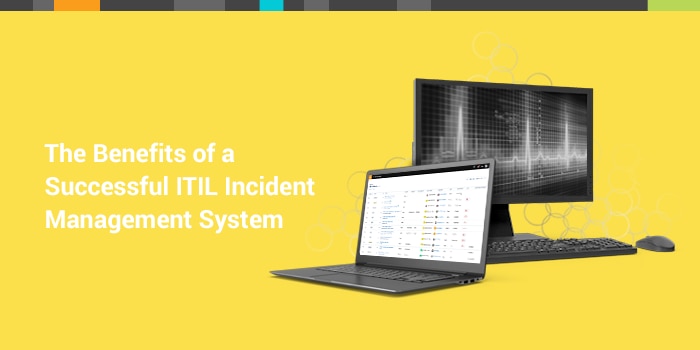Your service desk solution may come with a baked-in set of reports, but these aren't necessarily the most critical IT service management (ITSM) ITIL metrics or key performance indicators (KPIs) for your service team to track.
This metrics list is designed to provide brief definitions and explanations of 15 top metrics for service desk teams to track to help you achieve important business goals. Tracking the right metrics can help you more easily gain visibility into critical success factors, such as customer satisfaction, problem management processes,
change management KPIs, and business continuity initiatives, and help you optimize overall IT service desk performance.
At the end of the guide, I also provide one additional ITSM KPI metric sometimes overlooked by service desk teams (and borrowed from many IT organizations' playbooks) to help gain valuable insight into how to improve the customer experience.
KPIs to Track for ITSM
- Incident Response Time - The number of minutes/hours/days between the initial incident report and its successful resolution. The average resolution time to respond to an incident is often referred to as Mean Time To Resolve (MTTR).
Why it's a good ITSM KPI metric to track: Low MTTR and reopen rates are key indicators of effective customer service.
- First-Touch Resolution Rate - First-touch resolution rate is the percentage of incidents resolved the first time, with no repeat calls.
Why it's a good ITSM KPI metric to track: High first-time incident resolution correlates with greater customer satisfaction and is a good sign of incident management maturity.
- SLA Compliance Ratio - This ratio is the number of resolutions needed to fulfill service level agreement (SLA) guidelines related to response time, workflow prioritization, cost, and other metrics.
Why it's a good ITSM KPI metric to track: A high SLA compliance ratio helps ensure you meet obligations without unnecessary loss of productivity or revenue opportunities.
- Cost per Ticket - You can calculate this metric by totaling the money spent to resolve each reported incident. Add up the total budget for staff and technology to operate the service desk, and divide by the number of tickets resolved.
Why it's a good ITSM KPI metric to track: Understanding cost per ticket can help you identify more efficient problem-solving methods, such as evaluating the
average IT service desk to employee ratio. It's also one of the most straightforward ITSM financial performance metrics to calculate.
- Number of Active Tickets - The number of active tickets is defined as the current number of reported incidents yet to be resolved.
Why it's a good ITSM KPI metric to track: Keeping this number low helps ensure you're not overwhelmed by ticket creep or rising customer dissatisfaction if your tickets back up.
- Recategorized Incidents - Recategorized incidents are defined as the number of incidents misdiagnosed at creation. Sometimes, automated software tools or front-line service desk agents may be responsible for misdiagnosing incidents.
Why it's a good ITSM KPI metric to track: Improve this metric by cleaning up your categories and subcategories to help ensure accurate data collection upfront.
- Reopen Rate - The percentage of tickets revisited after initially being marked as resolved are defined as reopen rates.
Why it's a good ITSM KPI metric to track: Understanding high reopen rates can help you identify training opportunities for technicians or deeper problems with hardware or applications.
- Incidents per Department - Incidents per department is the total number of incidents initiated by each department within your organization.
Why it's a good ITSM KPI metric to track: This metric indicates which departments have the highest demand for services and identifies service gaps to allocate agents appropriately.
- Incidents by Type - This metric represents the number of incidents categorized by the affected device or application. By identifying the most troublesome devices and software, you can partner with each vendor as needed or consider other alternatives.
Why it's a good ITSM KPI metric to track: Tracking incident types can allow you to allocate your agents based on their skillsets to make decisions about training.
Encouraging employees to submit service requests via the service portal can help facilitate more accurate data collection when it comes to categories and subcategories, which makes this metric even more beneficial.
- Incidents Not Initiated via Self-Service - It's also important to keep track of the number of tickets opened via email, by phone, walk-up, or any other request type bypassing a self-service portal.
Why it's a good ITSM KPI metric to track: When separated by incident type, agent, or requestor, this metric can reveal inefficiencies and opportunities to improve your knowledge base.
- Incidents With Associated Problems - This metric represents the number of incidents associated with known problems.
Why it's a good ITSM KPI metric to track: Based on the total impact of each problem, tracking incidents with like problems can help you prioritize major repairs, updates, or CapEx decisions. With smart technology like artificial intelligence and automation,
modern service desk solutions can make it easier to identify related incidents indicative of problems.
- Escalated Incidents - Escalated incidents are the total number of incidents resolved by Level 2 or 3 team members.
Why it's a good ITSM KPI metric to track: An increase could suggest skills gaps for front-line team members. An uptick in escalated incidents may also indicate a need to increase the depth of your
service catalog by creating workflows for those types of complex requests.
- Incidents Resolved Remotely - Incidents resolved remotely are tracked by calculating the number of incidents resolved without dispatching a technician to the affected hardware.
Why it's a good ITSM KPI metric to track: This metric can reveal possible limitations in remote access tools and workflows.
- Incidents With No Known Resolution - Reporting on the number of tickets unable to be resolved with known interventions is one of the more critical ITSM metrics to track.
Why it's a good ITSM KPI metric to track: This can reveal agent skills gaps or holes in your
knowledge management system.
- Ticket Volume - Ticket volume represents the total number of tickets at any or over any given time.
Why it's a good ITSM KPI metric to track: Ticket volume can help identify trends to help predict what may be driving higher or lower ticket volumes. With this data, you can schedule agents accordingly, considering high-volume periods.
Bonus ITIL Metric: Customer Satisfaction
If your service desk solution provides automated
customer satisfaction (CSAT) surveys, take time to monitor these results to see how you're doing. Since happy, productive employees are generally your ultimate goal, CSAT results may be the most essential ITSM ITIL metric.
This post was originally published on July 11, 2017, and updated on May 9, 2019, and January 10, 2022, to reflect current ITSM best practices.






